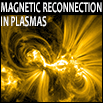Speaker
Dr
Yuri Khotyaintsev
(Swedish Institute of Space Physics)
Description
We use multi-spacecraft observations by Cluster and MMS in the
magnetotail and 3D PIC simulations to investigate conversion of
electromagnetic energy at the front of a fast plasma jet. Such plasma
jet can be produced as a result of magnetic reconnection.
Jet fronts are known to have a sharp increase of magnetic field
(referred to as dipolarization fronts in the magnetospheric physics) as
well as sharp gradients in plasma density and temperature. These
sharp gradients at the front generate broadband turbulence in the
lower-hybrid frequency range, which have amplitudes several times
larger than the convective field, wave potential comparable to
electron thermal energy, and perpendicular wavelength of the order of
several electron gyro-scales. Despite the large wave amplitudes, we
find only moderate dissipation due to these waves in the
front reference frame, which goes into heating of electrons.
We find that the major dissipation is happening in the Earth
(laboratory) frame and it is related to reflection and acceleration of ions
from the jet front. This dissipation operates at scales of the order
several ion inertial lengths, and the primary contribution to E*J is
coming from the convective electric field of the front (E=Vfront_x B)
and the current flowing at the front.
Author
Dr
Yuri Khotyaintsev
(Swedish Institute of Space Physics)
Co-authors
Dr
Alessandro Retinó
(Laboratoire de Physique des Plasmas, CNRS, Ecole Polytechnique, France)
Dr
Andrey Divin
(Saint Petersburg State University, Russia)
Dr
Andris Vaivads
(Swedish Institute of Space Physics)
Prof.
Christopher C. Russell
(University of California, Los Angeles, CA, USA)
Prof.
Mats André
(Swedish Institute of Space Physics)
Dr
Olivier Le Contel
(Laboratoire de Physique des Plasmas, CNRS, Ecole Polytechnique, France)
Dr
Per-Arne Lindqvist
(Royal Institute of Technology, Stockholm, Sweden)
Prof.
Robert R. Ergun
(University of Colorado, Boulder, CO, USA)
Prof.
Roy Torbert
(University of New Hampshire, Durham, NH, USA)
Dr
Werner Magnes
(Space Research Institute, Austrian Academy of Sciences, Graz, Austria)

